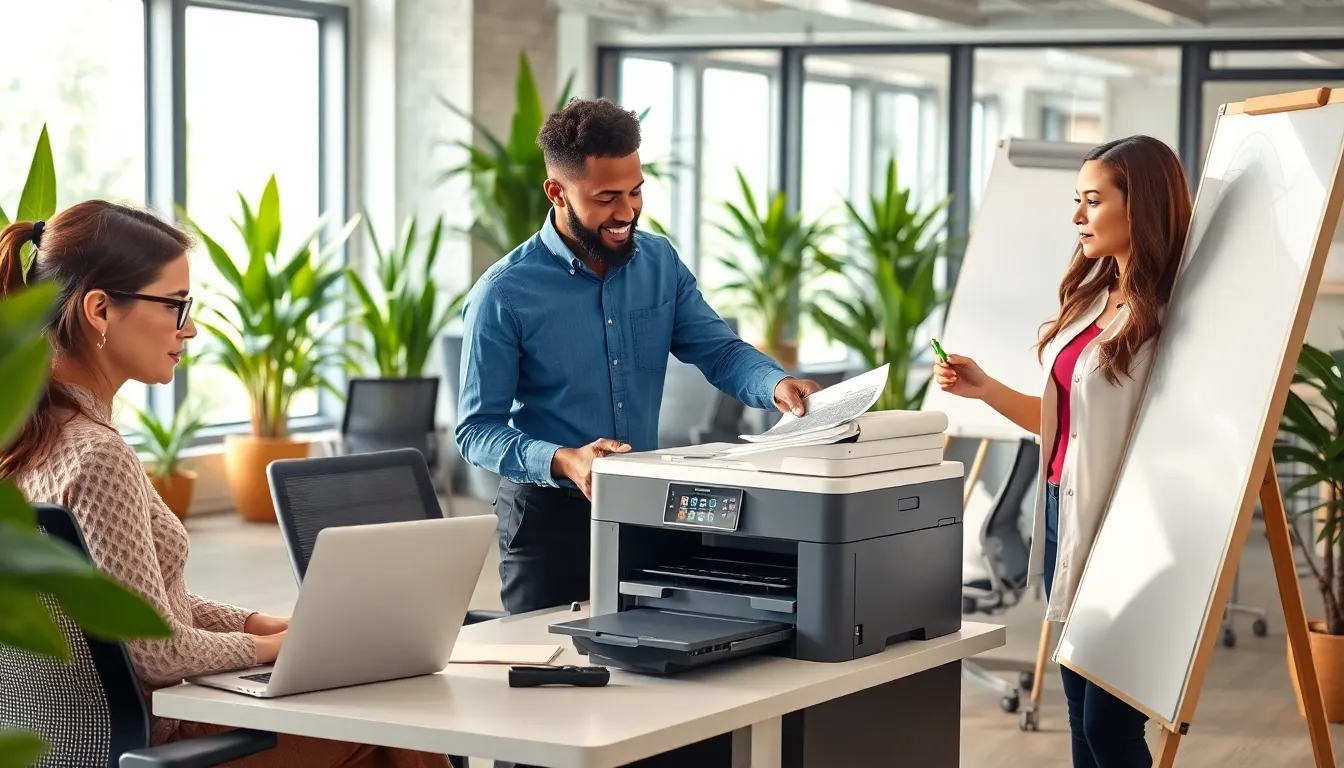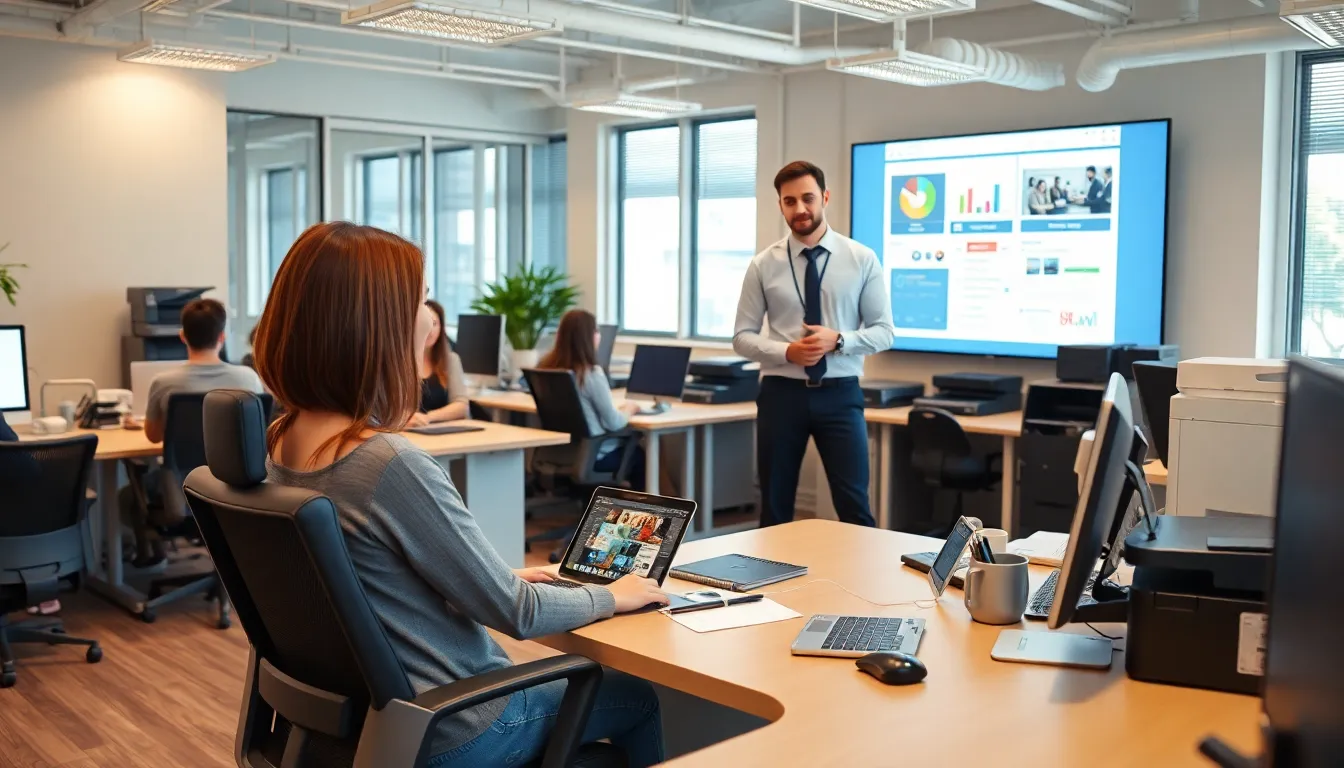Table of Contents
ToggleIn the bustling world of offices, where coffee flows like water and deadlines loom like storm clouds, the right office equipment can be a game changer. Imagine a printer that doesn’t jam every five minutes or a chair that doesn’t feel like a medieval torture device. With the right tools, productivity skyrockets and even the most mundane tasks can feel like a breeze.
Overview of Office Equipment
Office equipment plays a crucial role in maximizing workplace efficiency. Essential items include computers, printers, and copiers. Reliable technology boosts productivity by streamlining tasks and enabling quick communication.
Furniture also contributes to an effective office setup. Ergonomic chairs and desks improve comfort and reduce strain during long work hours. Employees can focus better when they’re comfortable and supported.
Hardware devices such as scanners and projectors facilitate seamless presentations and document management. With high-quality imaging, these devices enhance visual communication and collaboration among team members.
Moreover, office supplies like ink cartridges, paper, and staplers are vital for daily operations. Maintaining an inventory of these supplies ensures that workflows remain uninterrupted.
Some organizations opt for multifunction devices that combine printing, scanning, and copying capabilities. This choice can save space and reduce costs, making it an efficient investment for small offices.
Digital tools also align with modern office needs. Software applications for project management and communication simplify collaboration among remote teams. Utilizing cloud services allows employees to access documents from anywhere, fostering flexibility and productivity.
Prioritizing quality office equipment leads to improved work environments. Each piece of equipment, from technology to furniture, contributes to employee satisfaction and overall organizational effectiveness. Maintaining a well-equipped office directly supports ongoing success and growth.
Types of Office Equipment

Office environments require a variety of equipment to enhance productivity and ensure smooth operations. Understanding the types of office equipment helps teams select the right tools for their specific needs.
Essential Office Equipment
Computers serve as the backbone of daily operations, allowing employees to complete tasks efficiently. Printers and copiers make document management straightforward, providing hard copies for meetings or records. Ergonomic furniture, such as chairs and desks, supports employee comfort, which is vital for reducing fatigue. Additionally, telecommunication devices like phones facilitate instant communication among team members. Each of these essentials contributes to a productive workplace, enhancing overall efficiency.
Specialized Office Equipment
Specialized office equipment addresses unique tasks within different work environments. Scanners digitize documents, making storage and sharing easier. Projectors play a critical role in presentations, allowing teams to communicate ideas visually. Advanced software solutions enable effective project management and collaboration, especially in remote settings. Whiteboards and collaborative tools promote brainstorming sessions, fostering creativity among staff. Utilizing specialized equipment supports specific functions, improving operational effectiveness.
Benefits of Modern Office Equipment
Modern office equipment profoundly impacts workplace efficiency and employee satisfaction. The right tools enhance day-to-day operations while fostering a more productive work environment.
Enhancing Productivity
Up-to-date office equipment boosts productivity through increased speed and efficiency. Modern printers handle high-volume printing tasks quickly, while ergonomic chairs provide necessary comfort, reducing fatigue during long hours. Computers equipped with the latest software facilitate multitasking and streamline various processes. Furthermore, multifunction devices combine several functions into one, saving valuable time and physical space. Quick access to high-quality equipment allows employees to focus on core tasks instead of technical issues. During busy workdays, having reliable tools significantly enhances overall output.
Improving Communication
Effective communication thrives on modern office equipment. High-speed internet and advanced telecommunication devices enable seamless interactions among team members, regardless of location. Video conferencing tools foster real-time collaboration, making remote teamwork more efficient. Additionally, cloud services ensure easy sharing of documents and resources across platforms, preventing communication breakdowns. Effective office equipment simplifies information exchange, allowing teams to respond swiftly to changing demands. Strong communication channels empower employees and create a cohesive work atmosphere, driving organizational success.
Tips for Choosing Office Equipment
Selecting the right office equipment enhances productivity and creates a more efficient work environment. Focusing on needs and budget leads to informed choices.
Assessing Your Needs
Identifying specific tasks drives equipment selection. Consider essential tools like computers and printers that support daily operations. Evaluate the workspace layout to maximize functionality. Prioritize ergonomic features to enhance comfort and reduce fatigue. Assess the need for specialized equipment like scanners and projectors for unique tasks. Maintain a balance between essential and specialized devices to foster an adaptable work environment.
Budget Considerations
Establishing a budget ensures prudent spending. Analyze costs associated with essential items, such as desktop computers and multifunction printers. Factor in recurring expenses like ink, paper, and maintenance to understand total costs. Explore cost-effective solutions without compromising quality. Invest in durable office furniture and equipment to avoid frequent replacements. Plan for future expansions or upgrades to stay ahead in evolving workplace dynamics.
Maintenance and Care for Office Equipment
Caring for office equipment ensures longevity and performance. Regular cleaning of devices like printers and computers enhances functionality and prevents dust buildup. Inspecting cables and connections should occur frequently to avoid disruptions during critical tasks.
Lubricating moving parts of printers can reduce wear and tear. This simple maintenance step helps improve print quality and reliability. Moreover, updating software and drivers keeps equipment running smoothly and maximizes compatibility.
Checking ink or toner levels prevents unexpected interruptions. Ensuring adequate supplies of essential items supports continuous workflow. Replacing worn-out components promptly helps maintain optimal performance.
Scheduling routine maintenance for specialized equipment, such as scanners and projectors, enhances their longevity. Professional servicing can identify potential issues before they develop into costly problems. Developing a maintenance log tracks service dates and equipment performance.
Organizing workspace layout contributes to equipment care. Positioning devices to avoid overcrowding allows for proper ventilation, reducing overheating risks. Ensuring accessibility makes troubleshooting and routine checks easier.
Investing in quality equipment initially pays off in reduced maintenance costs over time. Prioritizing ergonomic features in furniture lessens strain on employees, promoting overall workplace comfort. A well-maintained office enhances productivity and supports ongoing success.
Investing in the right office equipment is essential for fostering a productive work environment. From ergonomic furniture to reliable technology each piece contributes to efficiency and comfort. By prioritizing quality tools organizations can enhance employee satisfaction and streamline daily operations.
Proper maintenance and thoughtful selection of equipment also play a crucial role. Regular upkeep ensures longevity while evaluating specific needs helps in making informed purchasing decisions. Ultimately a well-equipped office not only supports current demands but also adapts to future challenges fostering growth and success.


